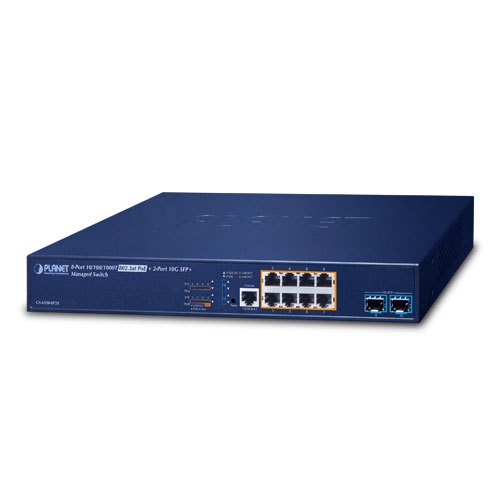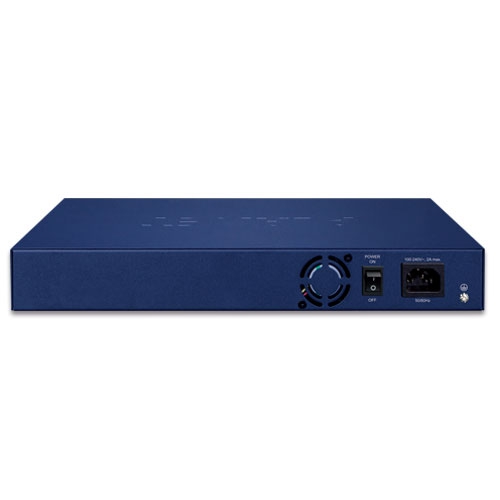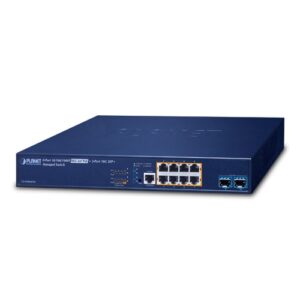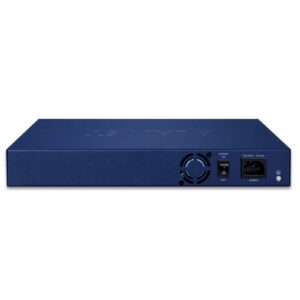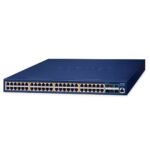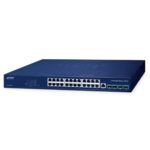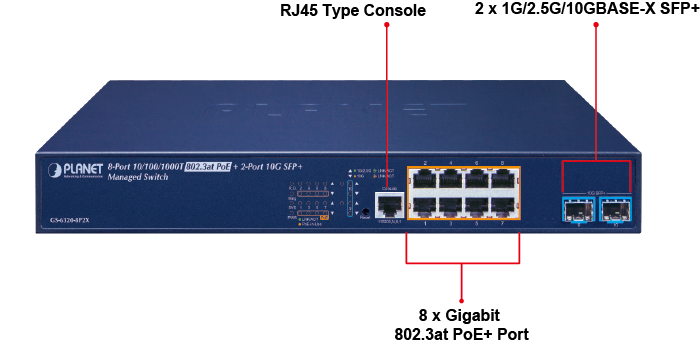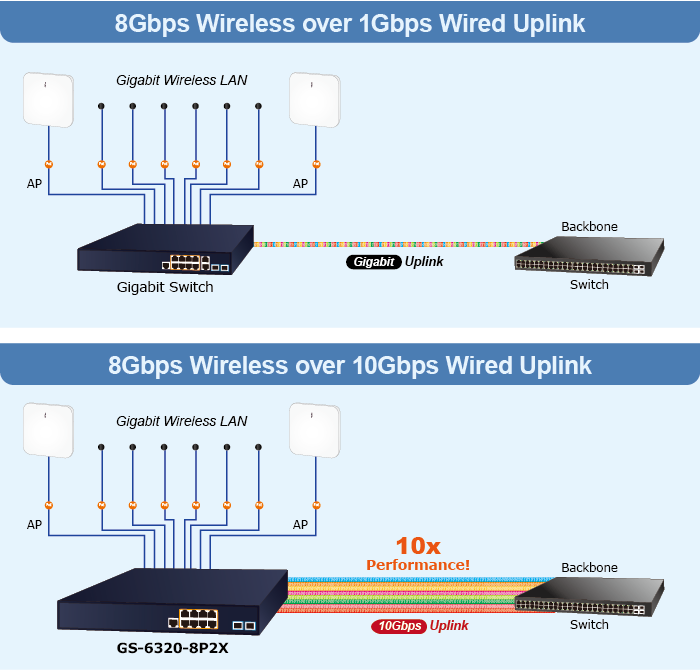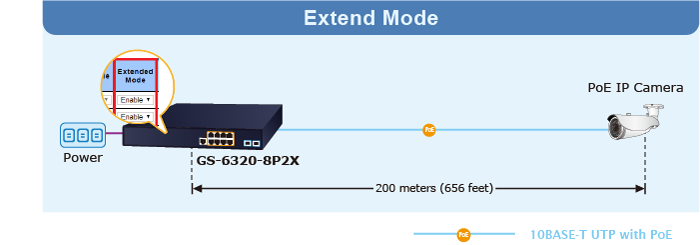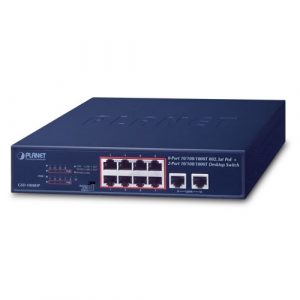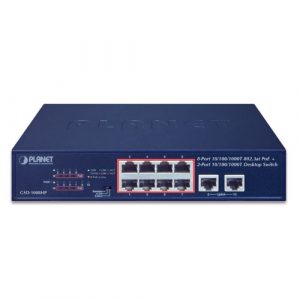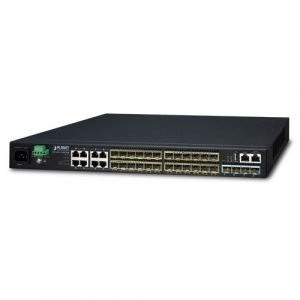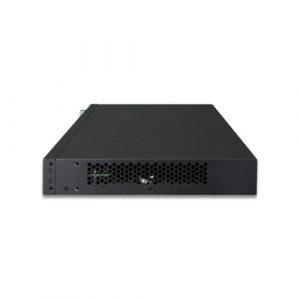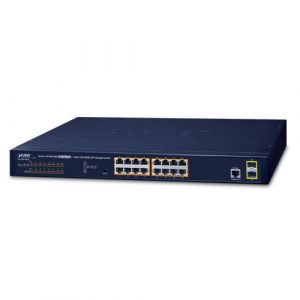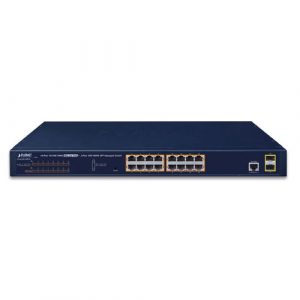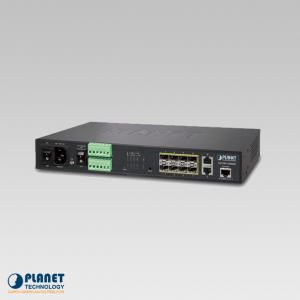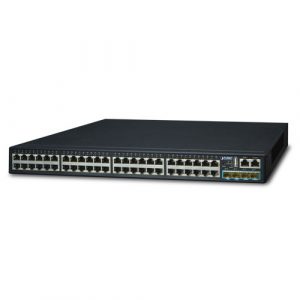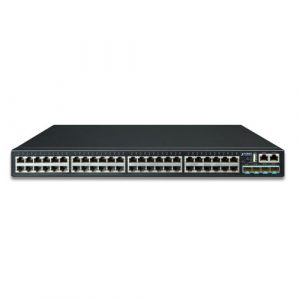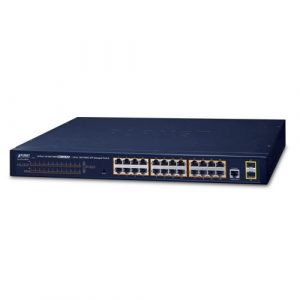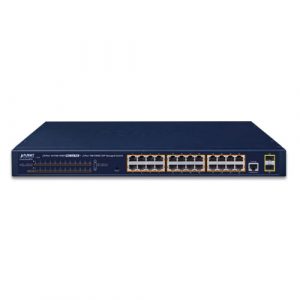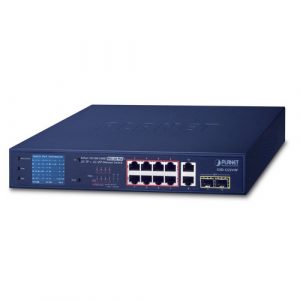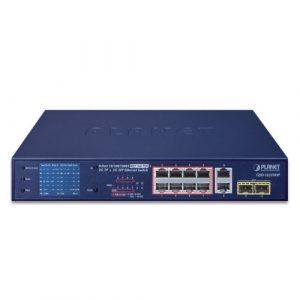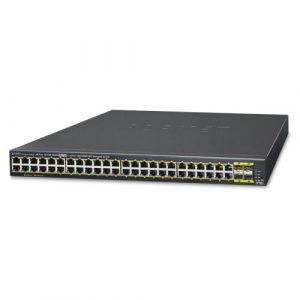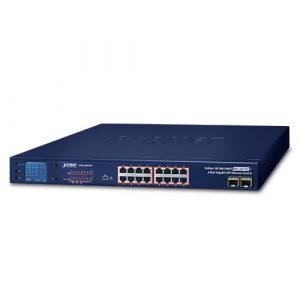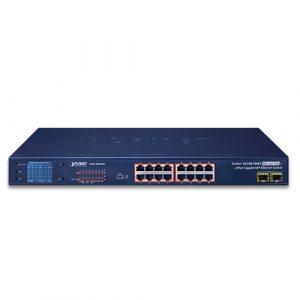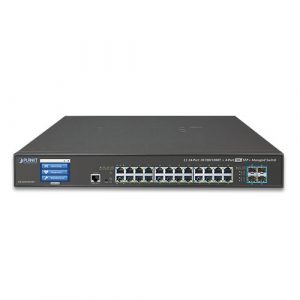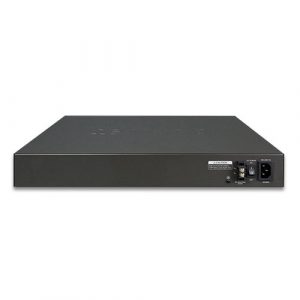GS-6320-8P2X
L3 8-Port 10/100/1000T 802.3at PoE + 2-Port 10G SFP+ Managed Switch
- Applicazioni
- DOWNLOAD
- SPECIFICHE
Descrizione
Switch PoE+ gestito perfetto con commutazione e sicurezza L3/L2
PLANET GS-6320-8P2X Layer 3 Managed Gigabit Switch supporta sia i protocolli IPv4 che IPv6 e il routing dinamico e statico OSPFv2 Layer 3 e fornisce 8 porte 10/100/1000BASE-T con PoE+ 802.3at e 2 slot in fibra extra 1/2.5/10 Gigabit BASE-X SFP+. Ognuna delle otto porte Gigabit fornisce 36 watt di potenza, con un budget di potenza totale fino a 120 watt per i diversi tipi di applicazioni PoE impiegate. Fornisce una soluzione di rete Power over Ethernet rapida, sicura e conveniente per la sorveglianza di sicurezza IP per piccole aziende e grandi aziende.
Routing statico VLAN Layer 3 e applicazione PoE
Con i robusti protocolli di routing del traffico IPv4/IPv6 Layer 3 integrati, il GS-6320-8P2X garantisce un routing affidabile tra VLAN e segmenti di rete. I protocolli di routing possono essere applicati tramite interfaccia VLAN con un massimo di 128 voci di routing. Il GS-6320-8P2X è sicuramente una soluzione conveniente e ideale per le aziende.
Fornendo fino a 8 porte Gigabit PoE+ e un’interfaccia di alimentazione in linea, il GS-6320-8P2X PoE+ Managed Switch può facilmente creare una rete di alimentazione controllata centralmente condivisa da AP Gigabit wireless, sistema telefonico IP o gruppo di sistemi di telecamere IP mega-pixel per le aziende.
Soluzione hotspot Wi-Fi PoE con infrastruttura di rete estesa per spazi pubblici
Il GS-6320-8P2X è dotato di design non bloccante, dimensioni desktop e moduli in fibra ottica SFP, offrendo all’infrastruttura di rete una maggiore flessibilità ma costi inferiori. Fornendo otto porte PoE+ 10/100/1000BASE-T, interfacce di alimentazione in linea e due interfacce SFP da 10 Gigabit, il GS-6320-8P2X può facilmente creare un sistema di autenticazione di rete su controller LAN wireless per le aziende. Ad esempio, può funzionare con il controller wireless e il server RADIUS per eseguire una sicurezza completa per l’autenticazione utente wireless con AP alimentati.
Anello ridondante, ripristino rapido per applicazioni di rete critiche
GS-6320-8P2X supporta la tecnologia ad anello ridondante e presenta una capacità di auto-ripristino rapida e potente per prevenire interruzioni e intrusioni esterne. Incorpora la tecnologia avanzata ITU-T G.8032 ERPS (Ethernet Ring Protection Switching) e Spanning Tree Protocol (802.1w RSTP) nella rete del cliente per migliorare l’affidabilità del sistema e i tempi di attività in ambienti difficili. In una determinata rete ad anello semplice, il tempo di ripristino potrebbe essere inferiore a 10 ms per riportare rapidamente la rete al normale funzionamento.
Funzioni PoE esclusive integrate per la gestione della sorveglianza
Come switch PoE gestito per la rete di sorveglianza, il GS-6320-8P2X presenta le seguenti funzioni di gestione PoE intelligenti:
- PD Alive Check
- Scheduled Power Recycling
- SMTP/SNMP Trap Event Alert
- PoE Schedule
- PoE Usage Monitoring
- PoE Extension
Estensione della distanza di trasmissione dati Ethernet e alimentazione PoE
Nella modalità di funzionamento “Extend”, il GS-6320-8P2X funziona su base per porta a 10 Mbps di funzionamento duplex, ma può supportare un’uscita di potenza PoE da 22 watt su una distanza fino a 200 metri, superando il limite di 100 m sul cavo Ethernet UTP. Con questa nuovissima funzionalità, il GS-6320-8P2X fornisce una soluzione aggiuntiva per l’estensione della distanza PoE 802.3at/af, risparmiando così il costo dell’installazione del cavo Ethernet.
Supporto di routing Layer 3
GS-6320-8P2X consente all’amministratore di aumentare comodamente l’efficienza della rete configurando manualmente il routing statico VLAN IPv4/IPv6 Layer 3, le impostazioni RIP (Routing Information Protocol) o OSPF (Open Shortest Path First) automaticamente. Il RIP può utilizzare il conteggio dei salti come metrica di routing e prevenire loop di routing implementando un limite al numero di salti consentiti in un percorso dalla sorgente alla destinazione. L’OSPF è un protocollo di routing dinamico interno per sistemi autonomi basato sullo stato del collegamento. Il protocollo crea un database per lo stato del collegamento scambiando gli stati del collegamento tra gli switch Layer 3, quindi utilizza l’algoritmo Shortest Path First per generare una tabella di routing basata su tale database.
| Hardware Specifications | |
|---|---|
| Copper Ports | 8 x 10/100/1000BASE-T RJ45 auto-MDI/MDI-X interface with Port-1 to Port-8 |
| SFP/mini-GBIC Slots | 2 x 1G/2.5G/10G BASE-X SFP interfaces with Port-9 to Port-10 |
| PoE Injector Port | 8 ports with 802.3at/af PoE injector function with Port-1 to Port-8 |
| Console | 1 x RJ45 serial port (115200 , 8, N, 1) |
| Reset Button | < 5 sec: System reboot > 5 sec: Factory default |
| Dimensions (W x D x H) | 330.2 x 153 x 44 mm, 1U height |
| Weight | 1.6 KG |
| Power Requirements | 100~240V AC, 50/60Hz |
| Power Consumption | Max. 14.8 watts/50.47BTU (Power on without any connection) Max. 162watts/552.42BTU (Full loading with PoE+ function) |
| ESD Protection | 6KV DC |
| LED | System: R.O. (Green), Ring (Green), SYS (Green), PWR (Green) 10/100/1000BASE-T RJ45 Interfaces (Port 1 to Port 8): 10/100/1000Mbps LNK/ACT (Green) PoE-in-Use (Amber) (Port 1 to Port 8) 1G/2.5G/10G Mbps SFP Interfaces (Port 9 to Port 10): 1G/2.5G LNK/ACT (Green) 10G LNK/ACT (Amber) |
| Switching Specifications | |
| Switch Architecture | Store-and-Forward |
| Switch Fabric | 56Gbps/non-blocking |
| Throughput | 41.67Mpps@ 64Bytes packet |
| Address Table | 8K entries, automatic source address learning and aging |
| Shared Data Buffer | 4.1Mbits |
| Flow Control | IEEE 802.3x pause frame for full-duplex Back pressure for half-duplex |
| Jumbo Frame | 9KB |
| Power over Ethernet | |
| PoE Standard | IEEE 802.3at PoE Plus, PSE Backward compatible with IEEE 802.3af PoE PSE |
| PoE Power Supply Type | End-span |
| PoE Power Output | Per port 52V DC, max. 36 watts |
| Power Pin Assignment | 1/2(+), 3/6(-) |
| PoE Power Budget | 120 watts (max.) @ 25 degrees C 100 watts (max.) @ 50 degrees C |
| PoE Ability | PD @ 7 watts: 8 units PD @ 15.4 watts: 7 units PD @ 30.8 watts: 3 units |
| PoE Management Functions | |
| PoE System Management | System PoE Admin control Auto power input and PoE budget control Over-temperature threshold alarm PoE usage threshold alarm |
| PoE Device Live Detects | Per port remote PD IP address 4 actions None PD reboot PR reboot and alarm Alarm |
| PoE Power Recycle | Yes, daily or predeinded schedule |
| PoE Schedule | 4 schedule profiles |
| PoE Extend Mode | Yes, max. 160 to 200 meters |
| Layer 3 Functions | |
| IP Interfaces | Max. 128 VLAN interfaces |
| Routing Table | Max. 128 routing entries |
| Routing Protocols | IPv4 RIPv2 IPv4 OSPFv2 IPv6 OSPFv3 IPv4 hardware static routing IPv6 hardware static routing |
| Layer 2 Functions | |
| Port Configuration | Port disable/enable Auto-negotiation 10/100/1000Mbps full and half duplex mode selection Flow Control disable/enable |
| Port Status | Display each port’s speed duplex mode, link status, flow control status, auto negotiation status, trunk status |
| Port Mirroring | TX/RX/Both Many-to-1 monitor Supports up to 5 sessions |
| VLAN | IEEE 802.1Q tag-based VLAN, IEEE 802.1ad Q-in-Q tunneling Private VLAN Edge (PVE) MAC-based VLAN Protocol-based VLAN Voice VLAN MVR (Multicast VLAN Registration) GVRP Up to 4K VLAN groups, out of 4094 VLAN IDs |
| Link Aggregation | IEEE 802.3ad LACP (static trunk) Supports 5 trunk groups with 2 ports per trunk |
| IGMP Snooping | IPv4 IGMP (v1/v2/v3) snooping IPv4 IGMP querier mode support Supports 255 IGMP groups |
| MLD Snooping | IPv6 MLD (v1/v2) snooping, IPv6 MLD querier mode support Supports 255 MLD groups |
| Ring | Supports ERPS, and complies with ITU-T G.8032 Recovery time < 10ms @ 3 nodes Recovery time < 50ms @ 16 nodes Supports Major ring and sub-ring |
| Bandwidth Control | Per port bandwidth control Ingress: 10Kbps~13000Mbps Egress: 10Kbps~13000Mbps |
| QoS | Traffic classification based, strict priority and WRR 8-level priority for switching Port number 802.1p priority 802.1Q VLAN tag DSCP/TOS field in IP packet |
| Security Functions | |
| Access Control List | IP-based ACL/MAC-based ACL ACL based on: MAC Address IP Address Ethertype Protocol Type VLAN ID DSCP 802.1p Priority Up to 256 entries |
| Security | Port security IP source guard Dynamic ARP inspection Command line authority control based on user level |
| AAA | RADIUS client TACACS+ client |
| Network Access Control | IEEE 802.1x port-based network access control MAC-based authentication Local/RADIUS authentication |
| Management Functions | |
| Basic Management Interfaces | Console; Telnet; Web browser; SNMP v1, v2c |
| Secure Management Interfaces | SSHv2, TLSv1.2, SNMPv3 |
| System Management | Firmware upgrade by HTTP protocol through Ethernet network Configuration upload/download through HTTP Remote Syslog System log LLDP protocol NTP PLANET Smart Discovery Utility PLANET CloudViewer app |
| Event Management | Remote Syslog System log SMTP |
| ONVIF | ONVIF device discovery ONVIF device monitoring Floor Map |
| SNMP MIBs | RFC 1213 MIB-II RFC 2863 IF-MIB RFC 1643 Ethernet MIB RFC 2863 Interface MIB RFC 2665 Ether-Like MIB RFC 2737 Entity MIB RFC 2819 RMON MIB (Groups 1, 2, 3 and 9) RFC 2618 RADIUS Client MIB RFC 3411 SNMP-Frameworks-MIB IEEE 802.1X PAE LLDP MAU-MIB Power over Ethernet MIB |
| Standards Conformance | |
| Regulatory Compliance | FCC Part 15 Class A, CE |
| Standards Compliance | IEEE 802.3 10BASE-T IEEE 802.3u 100BASE-TX IEEE 802.3z 1000BASE-SX/LX IEEE 802.3ab 1000BASE-T IEEE 802.3ae 10Gb/s Ethernet IEEE 802.3x flow control and back pressure IEEE 802.3ad port trunk with LACP IEEE 802.1D Spanning Tree Protocol IEEE 802.1w Rapid Spanning Tree Protocol IEEE 802.1s Multiple Spanning Tree Protocol IEEE 802.1p Class of Service IEEE 802.1Q VLAN tagging IEEE 802.1x Port Authentication Network Control IEEE 802.1ab LLDP IEEE 802.3af Power over Ethernet IEEE 802.3at Power over Ethernet Plus RFC 768 UDP RFC 793 TFTP RFC 791 IP RFC 792 ICMP RFC 2068 HTTP RFC 1112 IGMP v1 RFC 2236 IGMP v2 RFC 3376 IGMP v3 RFC 2710 MLD v1 RFC 3810 MLD v2 RFC 2328 OSPF v2 RFC 2453 RIP v2 |
| Environments | |
| Operating | Temperature: 0 ~ 50 degrees C Relative Humidity: 5 ~ 95% (non-condensing) |
| Storage | Temperature: -10 ~ 70 degrees C Relative Humidity: 5 ~ 95% (non-condensing) |



